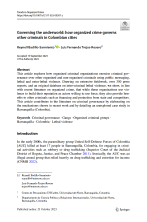By Bryce Pardo, Jirka Taylor, Jonathan P. Caulkins, Beau Kilmer, Peter Reuter, Bradley D. Stein
The U.S. opioid crisis worsened dramatically with the arrival of synthetic opioids, such as fentanyl, which are now responsible for tens of thousands of deaths annually. This crisis is far-reaching and even with prompt, targeted responses, many of the problems will persist for decades to come. RAND Corporation researchers have completed numerous opioid-related projects and have more underway for such clients and grantors as the Agency for Healthcare Research and Quality, the Assistant Secretary of Health and Human Services for Planning and Evaluation, the National Institute on Drug Abuse, the White House Office of National Drug Control Policy, and Pew Charitable Trusts. Researchers have advanced an understanding of the dimensions of the problem, some of the causes and consequences, and the effectiveness of different responses. However, no one has yet addressed the full scope of the problems associated with opioid use disorder and overdose deaths. Beginning in late 2018, the RAND Corporation initiated a comprehensive effort to understand the problem and responses to help reverse the tide of the opioid crisis. The project involves dozens of RAND experts in a variety of areas, including drug policy, substance use treatment, health care, public health, criminal justice, child welfare and other social services, education, and employment. In this work, we intend to describe the entire opioid ecosystem, identifying the components of the system and how they interact; establish concepts of success and metrics to gauge progress; and construct a simulation model of large parts of the ecosystem to permit an evaluation of the full effects of policy responses. We dedicated project resources and communications expertise to ensure that our products and dissemination activities are optimized for reaching our primary intended audiences: policymakers and other critical decision-makers and influencers, including those in the public, private, and nonprofit sectors. The project is ambitious in scope and will not be the last word on the subject, but by tackling the crisis in a comprehensive fashion, it promises to offer a unique and broad perspective in terms of the way the nation understands and responds to this urgent national problem. Ten years ago, few would have predicted that illicitly manufactured synthetic opioids from overseas would sweep through parts of Appalachia, New England, and the Midwest. As drug markets are flooded by fentanyl and other synthetic opioids, policymakers, researchers, and the public are trying to understand what to make of it and how to respond. The synthesis of heroin in the late 19th century displaced morphine and forever changed the opiate landscape, and we might again be standing at the precipice of a new era. Cheap, accessible, and mass-produced synthetic opioids could very well displace heroin, generating important and hard-to-predict consequences. As part of RAND’s project to stem the tide of the opioid crisis, this mixed-methods report offers a systematic assessment of the past, present, and possible futures of fentanyl and other synthetic opioids found in illicit drug markets in the United States. This research is rooted in secondary data analysis, literature and document reviews, international case studies, and key informant interviews. Our goal is to provide local, state, and national decision-makers who are concerned about rising overdose trends with insights that might improve their understanding of and responses to this problem. We also hope to provide new information to other researchers, media sources, and the public, who are contributing to these critical policy discussions
Santa Monica, CA: RAND, 2019. 265p.





















